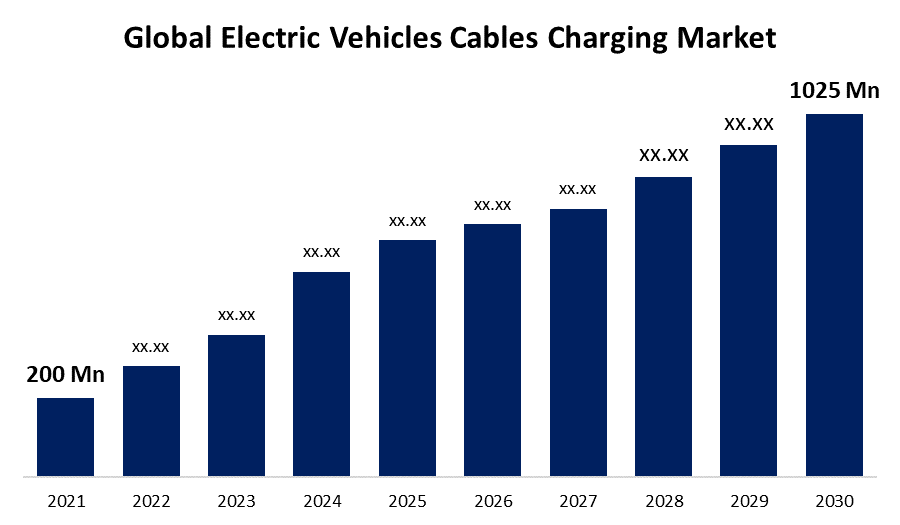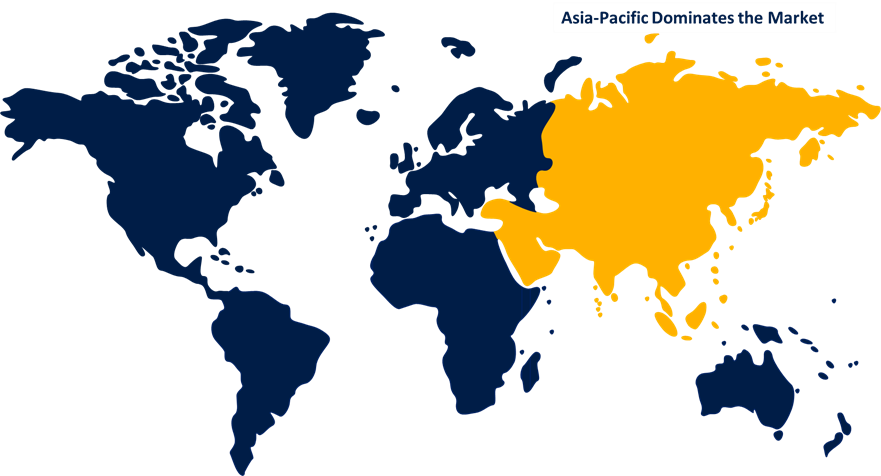Global Electric Vehicles Cables Charging Market Size, Share, and COVID-19 Impact Analysis, By Power Supply, By Cable Length, By Charging Level, By Shape, By Application, By Region (North America, Europe, Asia Pacific, Middle East & Africa, South America) Industry Analysis Report, Regional Outlook, Growth Potential, Price Trends, Competitive Market Share & Forecast, 2021 - 2030
Industry: Semiconductors & ElectronicsGlobal Electric Vehicles Cables Charging Market Insights Forecasts to 2030
The Global Electric Vehicles Cable Charging Market size was valued at USD 200 Million in 2021 and is expected to reach USD 1025 Million in 2030 at a CAGR of 26% from 2021 to 2030. Rechargeable battery packs are put in electric vehicles (EVs) to provide the energy needed to power them, and these batteries can be charged using public or private station outlets. The noise, air pollution, and greenhouse gas emissions associated with driving are drastically reduced with battery electric vehicles (BEVs), which are powered completely by electricity. The demand for EVs is being driven by the tightening of carbon dioxide emission standards in emerging markets.

Get more details on this report -
As a result, the demand for infrastructure for electric vehicle charging is growing exponentially. For instance, the International Energy Agency (IEA) reports that between 2017 and 2018, the number of EV charging stations worldwide increased by almost 44%. Over the following ten years, it is anticipated that such factors will increase demand for EV charging cables in emerging economies.
Over the course of the projection period, it is predicted that increasing EV adoption, expanding EV fast-charging cable demand, and swift development of EV supply equipment would support market expansion. For instance, there were more than 5.1 million electric cars in the world's fleet in 2020, an increase of 3 million from the year before.
Driving Factors
The use of EVs has increased, which has led to growth in the market for EV charging cables. Additionally, government worries about reducing carbon footprints are fueling demand for EV charging connections. Furthermore, the demand for quick charging cables will support market growth. Infrastructure upgrades for public EV charging stations and technological advancements in EV charging cables are expected to cause the market for EV charging cables to grow quickly.
Electric vehicle usage has grown over the past few years as a result of the technology's development, declining costs, growing support for environmentally friendly transportation, expanding charging options, and growing public awareness. Concerns over auto pollution and the depletion of non-renewable energy sources have also spurred a number of governments to spend money on electric cars. Even tax incentives for EV purchases have influenced consumers to purchase more EVs.
In response to the rising demand for high-speed charging stations, electric car charging cable manufacturers are developing complex cables for high-speed charging. An increase in government spending to build charging infrastructure is anticipated to stimulate the global market for electric car charging connections. Due to the widespread production of electric components, it is anticipated that the market for charging cables for electric vehicles will continue to expand significantly.
Restraining Factors
Fast charging cables are significantly more expensive than standard charging cables, costing roughly $127. The cost of charging cables for rapid charging stations may limit the amount that this technology is utilised. For example, establishing a slow charging station costs $1700 in the UK, which is a significant amount of money. Users will also embrace the newest models more and more when charging cable technology develops. Therefore, for some consumers, the initial cost of installing the charging station could result in large losses. These factors could all limit the market's ability to grow.
Electric Vehicles Cables Charging Market Report Coverage
| Report Coverage | Details |
|---|---|
| Base Year: | 2021 |
| Market Size in 2021: | USD 200 Million |
| Forecast Period: | 2021-2030 |
| Forecast Period CAGR 2021-2030 : | 26% |
| 2030 Value Projection: | USD 1025 Million |
| Historical Data for: | 2017-2020 |
| No. of Pages: | 235 |
| Tables, Charts & Figures: | 110 |
| Segments covered: | By Power Supply, By Cable Length, By Charging Level, By Shape, By Application, By Region, COVID-19 Impact Analysis |
| Companies covered:: | Leoni AG, Coroplast, Chengdu Khons Technology Co., Ltd., Phoenix Contact, Aptiv, BESEN-Group, General Cable Technologies Corporation, Dyden Corporation, TE Connectivity |
| Pitfalls & Challenges: | Due to the increasing number of COVID-19 cases |
Get more details on this report -
Segmentation
The global electric vehicles cables charging market is segmented into Cable Length, Charging Level, Shape, Application, and Region.
Global Electric Vehicles Cables Charging Market, By Cable Length
The market is divided into three categories based on cable length: below 5 metres, 6 metres to 10 metres, and above 10 metres. With approximately 55.0% of the market in 2021, the below 5 metres cable length segment led, and it is anticipated that it will continue to hold the lead throughout the forecast period. The increasing use of private electric vehicle charging stations around the world is largely to blame for this. Additionally, cables less than 5 metres are easier to store and utilise while being more effective for usage in household applications.
Global Electric Vehicles Cables Charging Market, By Charging Level
The market has been segmented into level 1, level 2, and level 3 charge levels. As they are increasingly used in residential and semi-commercial applications, including individual homes, apartments, condominiums, hotels, parking lots, and retail facilities, the level 2 category dominated the market in 2021 with a 51% share. From 2021 to 2030, the level 3 segment category is predicted to have the highest CAGR, at a rate of 28%. A Level 3 system has CHAdeMO technology, which recharges using 480V. A level 3 charger can recharge an electric car battery that has been completely depleted by 80% in less than 15 minutes. The main driver of the segment's growth is the high-power charging capability that can be accomplished in less than 30 minutes. The category is expected to experience growth over the forecast period as a result of the rising demand for fast charging systems in nations like China, South Korea, and Japan as well as the quick advancement of high-power electric car charging infrastructure.
Global Electric Vehicles Cables Charging Market, By Shape
Based on cable shape, the market has been segmented into straight and coiled cable. The market segment for coiled cable is anticipated to grow at the highest CAGR of 29% between 2021 and 2030. They are also known as spiral cables, and because they don't stretch out over the ground, they are simple to maintain and less likely to cause tripping hazards. As a result, these cables are more durable than straight cables and need less storage space. Additionally, it is anticipated that improvements would lower the cost of coiled cables, driving the segment's growth throughout the projection period.
Global Electric Vehicles Cables Charging Market, By Application
The market is segmented into applications for both private and public charging. With over 73.0% of the total revenue in 2021, the private charging segment dominated the market, and it is anticipated that it will continue to hold the lead throughout the forecast period. The widespread use of these electric vehicle charging stations for personal charging is responsible for this growth.
Global Electric Vehicles Cables Charging Market, By Region

Get more details on this report -
In 2021, Asia Pacific dominated the market and accounted for 60% of total revenue. China, South Korea, and Japan are principally responsible for this region's growth. The greatest market for electric vehicle charging cables is China. The governments of China and Japan have developed various policies and initiatives to encourage major market players to produce EV charging infrastructure in their home countries because they anticipated the growing potential of the worldwide market for EV supply equipment. The region's high density of EV charging stations is anticipated to boost regional market expansion throughout the projection period.
Recent Developments in Global Electric Vehicles Cables Charging Market
- In January 2021, TE Connectivity Ltd. unveiled the AMP+ charging inlet for hybrid and electric passenger and commercial vehicles. These gadgets are capable of controlling DC currents of 200 amps and AC currents of up to 32 amps.
- In April 2021, HUBER+SUHNER AG, a preeminent supplier of optical and electrical communication solutions, unveiled RADOX HPC500, a latest addition to the RADOX higher power range. This method for cooled charger cables allows for 500 Ampere continuous charging even in warm environments.
List of Key Companies
- Leoni AG
- Coroplast
- Chengdu Khons Technology Co., Ltd.
- Phoenix Contact
- Aptiv
- BESEN-Group
- General Cable Technologies Corporation
- Dyden Corporation
- TE Connectivity
Segmentation
By Cable Length
- Below 5 meters
- 6 meters to 10 meters
- Above 10 meters
By Charging Level
- Level 1
- Level 2
- Level 3
By Shape
- Straight Cable
- Coiled Cable
By Application
- Private Charging
- Public Charging
By Region
North America
- North America, by Country
- U.S.
- Canada
- Mexico
- North America, by Cable Length
- North America, by Charging Level
- North America, by Shape
- North America, by Application
Europe
- Europe, by Country
- Germany
- Russia
- U.K.
- France
- Italy
- Spain
- The Netherlands
- Rest of Europe
- Europe, by Cable Length
- Europe, by Charging Level
- Europe, by Shape
- Europe, by Application
Asia Pacific
- Asia Pacific, by Country
- China
- India
- Japan
- South Korea
- Australia
- Indonesia
- Rest of Asia Pacific
- Asia Pacific, by Cable Length
- Asia Pacific, by Charging Level
- Asia Pacific, by Shape
- Asia Pacific, by Application
Middle East & Africa
- Middle East & Africa, by Country
- UAE
- Saudi Arabia
- Qatar
- South Africa
- Rest of Middle East & Africa
- Middle East & Africa, by Cable Length
- Middle East & Africa, by Charging Level
- Middle East & Africa, by Shape
- Middle East & Africa, by Application
South America
- South America, by Country
- Brazil
- Argentina
- Colombia
- Rest of South America
- South America, by Cable Length
- South America, by Charging Level
- South America, by Shape
- South America, by Application
Need help to buy this report?